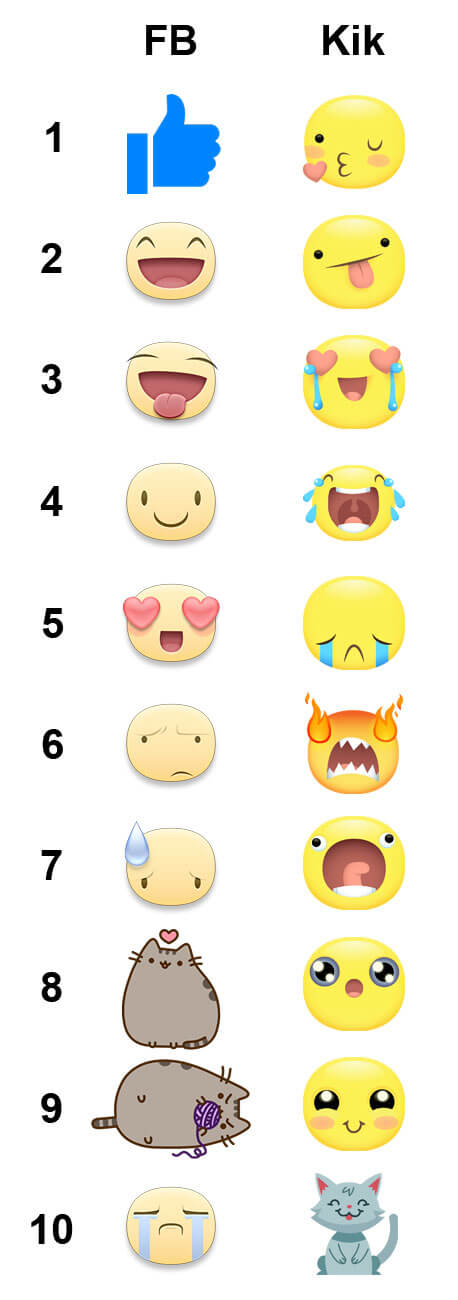At Dashbot, we’ve processed almost 700 million messages through our platform.
One of the interesting aspects of conversational interfaces is the unstructured data users send through bots — everything from text to images, stickers, video, audio, links, location maps, and more.
We took a deeper look at images and stickers sent to Facebook and Kik bots on our platform during the month of December.
Stick’em up!
Stickers are more than just an image — they’re communicating feelings and emotions.
June 5th: The AI Audit in NYC
Join us next week in NYC to engage with top executive leaders, delving into strategies for auditing AI models to ensure fairness, optimal performance, and ethical compliance across diverse organizations. Secure your attendance for this exclusive invite-only event.
Nearly 44 percent of Facebook bots and 54 percent of Kik bots receive stickers from users.
As you can see for both Facebook and Kik, emoticon stickers tend to be most popular… along with cats!

Analyzing the types of stickers provides an opportunity to better respond to users, which can increase user satisfaction and the overall engagement in your bot.
The gift of animated gifs…
Similar way to stickers, animated images are another way of communicating emotions and feelings.
Nearly 14.5 percent of Facebook bots receive animated images.
These are the most common animated images based on number of bots and number of messages, respectively:
Most Common Gifs (based on number of bots):





Most Common Gifs (based on number of messages):





Want to chat? Here’s my selfie…
In the case of images, about 37 percent of Facebook bots and 62 percent of Kik bots receive images.
We ran the images from December through Amazon’s Rekognition API for image detection. The API outputs labels detected with the confidence level of detection. We filtered the labels further to look at labels with greater than 90 percent confidence level.
The most common labels for images based on the number of bots receiving them are listed below:

The most common type of image, whether by number of bots or number of messages, are images of people — often selfies. Person, Human, People, and Portrait are images of people and often skew to selfies, although keep in mind Selfie is a label as well.
For further clarity, on the labels:
- Poster and Collage generally applied to collages of images, most often collages of people and selfies
- Flyer and Brochure include images with text
- Text included pictures with text, a decent amount of photos of receipts, sms/text screenshots, and other writings
- Paper is similar to Text, but skews more to photos of writing on paper
- Animal and Mammal contain all types of animals, from pets to wildlife
- Trademark and Logo were similar — images of brand logos
An interesting takeaway with Kik is that Comics, Manga, and Drawing rated more highly than in Facebook.
Why are these important?
This is another opportunity to better understand your users. Why are they sending images, and what’s the context of the images? This is also an opportunity to provide support for images, which can increase user engagement.
As an example, we had a customer who didn’t realize the number of images being sent to their bot and initially ignored them. Once they saw the quantity, they started responding and acknowledging the images, creating a personality for the bot that resulted in an overall increase in user engagement.
Is there a gender bias?
In the case of Facebook, we can further drill into the labels based on gender. Here’s what we found:

In the case of images from female users, we see more Portrait, Collage, and Head labels, which generally are applied to Selfie-type photos. Even the Electronics label is often triggered by the phone in the image when taking a selfie in a mirror.
For images from male users, there are slightly more labels around Vehicles/Cars, and the addition of Food and Pets.
My eyes, my eyes!
Lastly, we took a look at NSFW images — our poor eyes — these aren’t for the faint of heart.
Thankfully, it turns out the relative number of NSFW images is quite low — only about 2.5 percent of images to Facebook and 1.6 percent of images to Kik were NSFW, and a relatively small percentage of bots receive them — e.g., 6 percent of Facebook bots. An even smaller number of users send NSFW images — in the case of Facebook it’s less than 1 percent (~0.9 percent) and with Kik it’s around 2.7 percent.
In the case of Facebook, both male and female users send NSFW images, although it leans heavily toward male users — of the NSFW images, around 90 percent were sent by males.
The interesting thing is, while it’s a small number of users and images, the users send the images a lot!
When a user sends an NSFW image, they generally don’t send it only once. In fact, on Facebook, the same NSFW image is sent on average 4.75 times. Males will send the same NSFW image about 5.1 times, whereas females will send the same image 2.8 times. There are even users who have sent the same NSFW image over 100 times! Apparently, once you’ve crossed the threshold of sending an NSFW image, you’re ok sending the same image multiple times.
Arte Merritt is the CEO and cofounder of Dashbot.io


